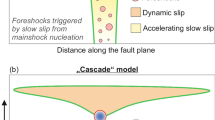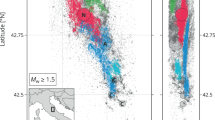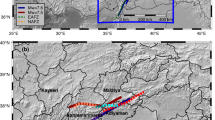Abstract
Arising from: E. L. Olson & R. M. Allen Nature 438, 212–215 (2005); Olson & Allen reply
It is essential in an earthquake early-warning system to be able rapidly to determine the size and location of an earthquake. Olson and Allen1 claim that the size of large earthquakes (magnitude (M) greater than 5.5) can be estimated from the seismic energy radiated during the first several seconds of fault rupture, implying that the earthquake process is deterministic. But here we analyse waveform data from more than 50 events (M≥6.0) recorded by the Japanese Hi-net seismic network and find no evidence that earthquake magnitude can be estimated before the rupture has completed. This bears on the difficult problem of understanding the physics of the earthquake process2.
This is a preview of subscription content, access via your institution
Access options
Subscribe to this journal
Receive 51 print issues and online access
$199.00 per year
only $3.90 per issue
Buy this article
- Purchase on Springer Link
- Instant access to full article PDF
Prices may be subject to local taxes which are calculated during checkout


Similar content being viewed by others
References
Olson, E. L. & Allen, R. M. Nature 438, 212–215 (2005).
Sato, K. & Mori, J. J. Geophys. Res. 111, B05307 (2006).
Allen, R. M. & Kanamori, H. Science 300, 786–789 (2003).
Kanamori, H. J. Geophys. Res. 82, 2981–2987 (1977).
Sacks, I. S. & Rydelek, P. A. Bull. Seismol. Soc. Am. 85, 808–813 (1995).
Kamigaichi, O. J. Jpn Assoc. Earthquake Eng. 4, 134–137 (2004).
Wald, D. J., Heaton, T. H. & Hudnut, K. W. Bull. Seismol. Soc. Am. 86, S49–S70 (1996).
Horiuchi, S., Negishi, H., Abe, K., Kamimura, A. & Fujinawa, Y. Bull. Seismol. Soc. Am. 95, 708–718 (2005).
Rydelek, P. A. & Pujol, J. Bull. Seismol. Soc. Am. 94, 1546–1550 (2004).
Tsuboi, C. Zisin 7, 185–193 (1954).
Author information
Authors and Affiliations
Corresponding author
Rights and permissions
About this article
Cite this article
Rydelek, P., Horiuchi, S. Is earthquake rupture deterministic?. Nature 442, E5–E6 (2006). https://doi.org/10.1038/nature04963
Published:
Issue Date:
DOI: https://doi.org/10.1038/nature04963
This article is cited by
-
High-temporal-resolution quasideterministic dynamics of granular stick-slip
Scientific Reports (2021)
-
Hierarchical rupture growth evidenced by the initial seismic waveforms
Nature Communications (2018)
-
\(\varvec{\tau}_{ps}\) τ p s , a new magnitude scaling parameter for earthquake early warning
Bulletin of Earthquake Engineering (2018)
-
Rapid and reliable seismic source characterization in earthquake early warning systems: current methodologies, results, and new perspectives
Journal of Seismology (2016)
-
Wavelet-Based Methods for Rapid Calculations of Magnitude and Epicentral Distance: An Application to Earthquake Early Warning System
Pure and Applied Geophysics (2015)
Comments
By submitting a comment you agree to abide by our Terms and Community Guidelines. If you find something abusive or that does not comply with our terms or guidelines please flag it as inappropriate.



